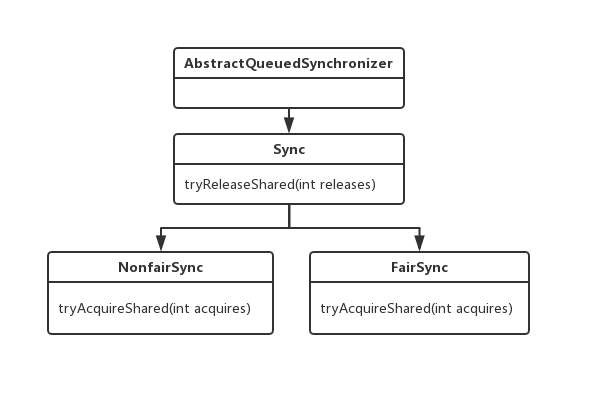Semaphore用于管理信号量,在并发编程中,可以控制返访问同步代码的线程数量。Semaphore在实例化时传入一个int值,也就是指明信号数量。主要方法有两个:acquire()和release()。acquire()用于请求信号,每调用一次,信号量便少一个。release()用于释放信号,调用一次信号量加一个。信号量用完以后,后续使用acquire()方法请求信号的线程便会加入阻塞队列挂起。本篇简单分析Semaphore的源码,说明其实现原理。
Semaphore对于信号量的控制是基于AQS(AbstractQueuedSynchronizer)来做的。Semaphore有一个内部类Sync继承了AQS。而且Semaphore中还有两个内部类FairSync和NonfairSync继承Sync,也就是说Semaphore有公平锁和非公平锁之分。以下是Semaphore中内部类的结构:

看一下Semaphore的两个构造函数:
public Semaphore(int permits) { sync = new NonfairSync(permits); } public Semaphore(int permits, boolean fair) { sync = fair ? new FairSync(permits) : new NonfairSync(permits); }
默认是非公平锁。两个构造方法都必须传int permits值。
这个int值在实例化内部类时,被设置为AQS中的state。
Sync(int permits) { setState(permits); }
一、acquire()获取信号
内部类Sync调用AQS中的acquireSharedInterruptibly()方法
public final void acquireSharedInterruptibly(int arg) throws InterruptedException { if (Thread.interrupted()) throw new InterruptedException(); if (tryAcquireShared(arg) < 0) doAcquireSharedInterruptibly(arg); }
- 调用tryAcquireShared()方法尝试获取信号。
- 如果没有可用信号,将当前线程加入等待队列并挂起
tryAcquireShared()方法被Semaphore的内部类NonfairSync和FairSync重写,实现有一些区别。
NonfairSync.tryAcquireShared()
final int nonfairTryAcquireShared(int acquires) { for (;;) { int available = getState(); int remaining = available - acquires; if (remaining < 0 || compareAndSetState(available, remaining)) return remaining; } }
可以看到,非公平锁对于信号的获取是直接使用CAS进行尝试的。
FairSync.tryAcquireShared()
protected int tryAcquireShared(int acquires) { for (;;) { if (hasQueuedPredecessors()) return -1; int available = getState(); int remaining = available - acquires; if (remaining < 0 || compareAndSetState(available, remaining)) return remaining; } }
- 先调用hasQueuedPredecessors()方法,判断队列中是否有等待线程。如果有,直接返回-1,表示没有可用信号
- 队列中没有等待线程,再使用CAS尝试更新state,获取信号
再看看acquireSharedInterruptibly()方法中,如果没有可用信号加入队列的方法doAcquireSharedInterruptibly()
private void doAcquireSharedInterruptibly(int arg) throws InterruptedException { final Node node = addWaiter(Node.SHARED); // 1 boolean failed = true; try { for (;;) { final Node p = node.predecessor(); if (p == head) { // 2 int r = tryAcquireShared(arg); if (r >= 0) { setHeadAndPropagate(node, r); p.next = null; // help GC failed = false; return; } } if (shouldParkAfterFailedAcquire(p, node) && // 3 parkAndCheckInterrupt()) throw new InterruptedException(); } } finally { if (failed) cancelAcquire(node); } }
- 封装一个Node节点,加入队列尾部
- 在无限循环中,如果当前节点是头节点,就尝试获取信号
- 不是头节点,在经过节点状态判断后,挂起当前线程
二、release()释放信号
public final boolean releaseShared(int arg) { if (tryReleaseShared(arg)) { // 1 doReleaseShared(); // 2 return true; } return false; }
- 更新state加一
- 唤醒等待队列头节点线程
tryReleaseShared()方法在内部类Sync中被重写
protected final boolean tryReleaseShared(int releases) { for (;;) { int current = getState(); int next = current + releases; if (next < current) // overflow throw new Error("Maximum permit count exceeded"); if (compareAndSetState(current, next)) return true; } }
这里也就是直接使用CAS算法,将state也就是可用信号,加1。
看看Semaphore具体的使用示例:
public static void main(String[] args) { ThreadPoolExecutor threadPool = new ThreadPoolExecutor(10, 10, 0L, TimeUnit.MILLISECONDS, new LinkedBlockingQueue<Runnable>(10)); //信号总数为5 Semaphore semaphore = new Semaphore(5); //运行10个线程 for (int i = 0; i < 10; i++) { threadPool.execute(new Runnable() { @Override public void run() { try { //获取信号 semaphore.acquire(); System.out.println(Thread.currentThread().getName() + "获得了信号量,时间为" + System.currentTimeMillis()); //阻塞2秒,测试效果 Thread.sleep(2000); System.out.println(Thread.currentThread().getName() + "释放了信号量,时间为" + System.currentTimeMillis()); } catch (InterruptedException e) { e.printStackTrace(); } finally { //释放信号 semaphore.release(); } } }); } threadPool.shutdown(); }
代码结果为:
pool-1-thread-2获得了信号量,时间为1550584196125 pool-1-thread-1获得了信号量,时间为1550584196125 pool-1-thread-3获得了信号量,时间为1550584196125 pool-1-thread-4获得了信号量,时间为1550584196126 pool-1-thread-5获得了信号量,时间为1550584196127 pool-1-thread-2释放了信号量,时间为1550584198126 pool-1-thread-3释放了信号量,时间为1550584198126 pool-1-thread-4释放了信号量,时间为1550584198126 pool-1-thread-6获得了信号量,时间为1550584198126 pool-1-thread-9获得了信号量,时间为1550584198126 pool-1-thread-8获得了信号量,时间为1550584198126 pool-1-thread-1释放了信号量,时间为1550584198126 pool-1-thread-10获得了信号量,时间为1550584198126 pool-1-thread-5释放了信号量,时间为1550584198127 pool-1-thread-7获得了信号量,时间为1550584198127 pool-1-thread-6释放了信号量,时间为1550584200126 pool-1-thread-8释放了信号量,时间为1550584200126 pool-1-thread-10释放了信号量,时间为1550584200126 pool-1-thread-9释放了信号量,时间为1550584200126 pool-1-thread-7释放了信号量,时间为1550584200127
可以看到,最多5个线程获得信号,其它线程必须等待获得信号的线程释放信号。